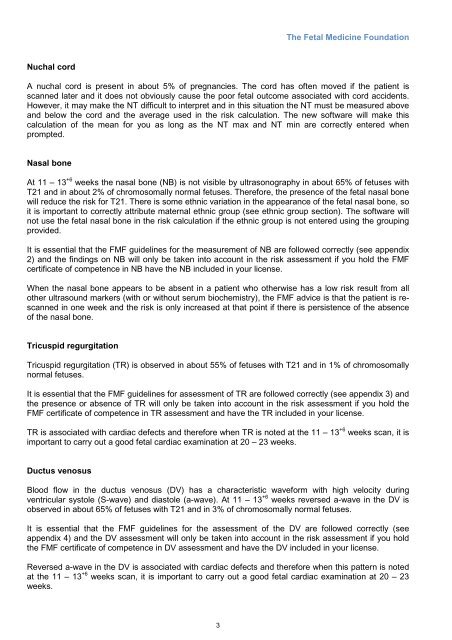Fetal Medicine Foundation First Trimester Screening
Fetal Medicine Foundation First Trimester Screening
Fetal Medicine Foundation First Trimester Screening
You also want an ePaper? Increase the reach of your titles
YUMPU automatically turns print PDFs into web optimized ePapers that Google loves.
The <strong>Fetal</strong> <strong>Medicine</strong> <strong>Foundation</strong><br />
Nuchal cord<br />
A nuchal cord is present in about 5% of pregnancies. The cord has often moved if the patient is<br />
scanned later and it does not obviously cause the poor fetal outcome associated with cord accidents.<br />
However, it may make the NT difficult to interpret and in this situation the NT must be measured above<br />
and below the cord and the average used in the risk calculation. The new software will make this<br />
calculation of the mean for you as long as the NT max and NT min are correctly entered when<br />
prompted.<br />
Nasal bone<br />
At 11 – 13 +6 weeks the nasal bone (NB) is not visible by ultrasonography in about 65% of fetuses with<br />
T21 and in about 2% of chromosomally normal fetuses. Therefore, the presence of the fetal nasal bone<br />
will reduce the risk for T21. There is some ethnic variation in the appearance of the fetal nasal bone, so<br />
it is important to correctly attribute maternal ethnic group (see ethnic group section). The software will<br />
not use the fetal nasal bone in the risk calculation if the ethnic group is not entered using the grouping<br />
provided.<br />
It is essential that the FMF guidelines for the measurement of NB are followed correctly (see appendix<br />
2) and the findings on NB will only be taken into account in the risk assessment if you hold the FMF<br />
certificate of competence in NB have the NB included in your license.<br />
When the nasal bone appears to be absent in a patient who otherwise has a low risk result from all<br />
other ultrasound markers (with or without serum biochemistry), the FMF advice is that the patient is rescanned<br />
in one week and the risk is only increased at that point if there is persistence of the absence<br />
of the nasal bone.<br />
Tricuspid regurgitation<br />
Tricuspid regurgitation (TR) is observed in about 55% of fetuses with T21 and in 1% of chromosomally<br />
normal fetuses.<br />
It is essential that the FMF guidelines for assessment of TR are followed correctly (see appendix 3) and<br />
the presence or absence of TR will only be taken into account in the risk assessment if you hold the<br />
FMF certificate of competence in TR assessment and have the TR included in your license.<br />
TR is associated with cardiac defects and therefore when TR is noted at the 11 – 13 +6 weeks scan, it is<br />
important to carry out a good fetal cardiac examination at 20 – 23 weeks.<br />
Ductus venosus<br />
Blood flow in the ductus venosus (DV) has a characteristic waveform with high velocity during<br />
ventricular systole (S-wave) and diastole (a-wave). At 11 – 13 +6 weeks reversed a-wave in the DV is<br />
observed in about 65% of fetuses with T21 and in 3% of chromosomally normal fetuses.<br />
It is essential that the FMF guidelines for the assessment of the DV are followed correctly (see<br />
appendix 4) and the DV assessment will only be taken into account in the risk assessment if you hold<br />
the FMF certificate of competence in DV assessment and have the DV included in your license.<br />
Reversed a-wave in the DV is associated with cardiac defects and therefore when this pattern is noted<br />
at the 11 – 13 +6 weeks scan, it is important to carry out a good fetal cardiac examination at 20 – 23<br />
weeks.<br />
3
















